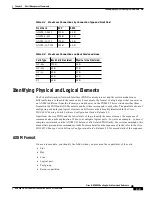
C H A P T E R
2-1
Cisco MGX 8850 Routing Switch Command Reference
Release 2.0, Part Number 78-10467-04 Rev C0, October 2001
2
Shelf Management Commands
This chapter describes the shelf management commands and some commands that belong to other
logical entities running on the switch—PNNI, for example. These commands allow you to add, delete,
configure, display status for, and create statistics for node-level features.
The functional areas under shelf management are:
•
Node-level parameters of nodename, date, time, time zone, and so on.
•
Firmware downloading.
•
Network synchronization
•
SNMP configuration
•
User account creation (and associated password)
•
IP connectivity to support user-control of the switch
•
Saving and restoring node configuration information
Position-Dependent and Keyword-Driven Parameters
A command can include parameters that are keyword-driven or position-dependent.
For position-dependent parameters, you must type parameters in the order they appear in the syntax
description or on-line help. To create a logical port, for example, the position-dependent syntax is:
addport <ifNum> <bay.line> <guaranteedRate> <maxrate> <sctID> <ifType> [vpi]
For a keyword-driven parameter, a keyword must precede the value. The keyword is preceded by a dash
and followed by the parameter (–timeout <secs>, for example). The order you enter keyword-driven
parameters does not matter—although any preceding or succeeding, position-dependent parameters
must appear as they do in the command syntax description.
In the following syntax example, the command is to delete more than one connection at a time. The
mandatory, position-dependent connection identifier consist of a logical port (ifNum) and the VPI and
VCI of the first connection to delete. After the connection identifier, the line shows two optional,
keyword-driven parameters. These keyword-driven parameters let you enter the number of connections
to delete and specify verbose mode:
delcons <ifNum> <vpi> <vci> [-num <num. conns to del>] [-verbose < 1 | 0 >]
















































